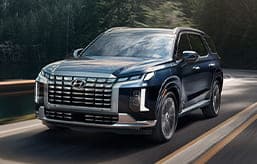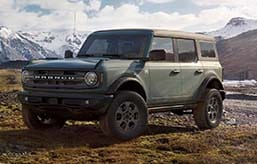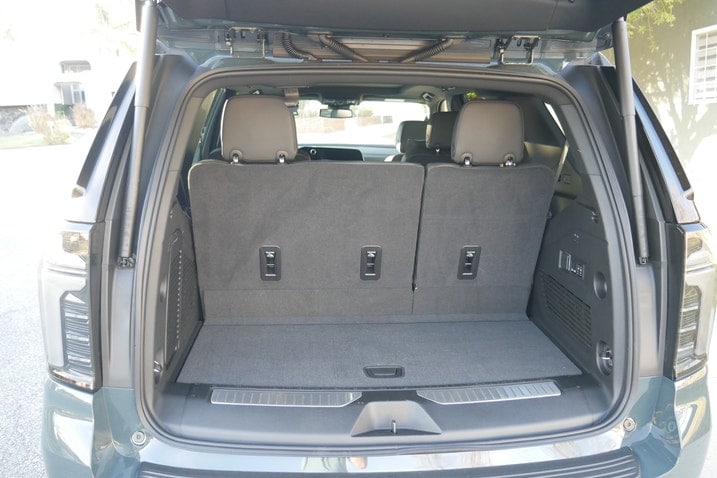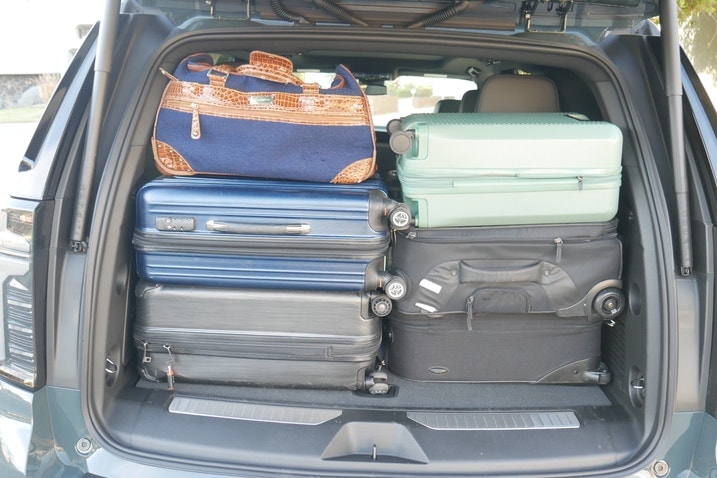- Chevrolet Tahoe specs say there's 25.5 cubic feet of cargo space behind the third row.
- That's more than Chevy's smaller Traverse crossover.
- Our real-world test shows how much you can fit behind the third row.
Chevy Tahoe Cargo Test: How Much Fits Behind the Third Row?
And how does its cargo space compare to the Traverse and Suburban?
The Chevrolet Tahoe's specs say it has 25.5 cubic feet of cargo space behind the third row, and that figure is not the best in its segment. That honor goes to the Jeep Wagoneer at 27.4 cubes, but Chevy's full-size SUV is likely No. 2. The Nissan Armada has 20.4 cubic feet, the Toyota Sequoia has 11.5 cubes (for real), and while Ford has not published a figure for the new 2025 Expedition, it was smaller than the Tahoe before. Spoiler alert: My tests show that the Wagoneer can in fact hold more stuff than the Tahoe. The comparisons I'm going to focus on here, though, are within the Chevrolet family: the Traverse crossover and the Tahoe's lengthened sibling, the Suburban.
Behold the Tahoe's cargo area in all its glory. As a brief history lesson, this is the first Tahoe with an independent rear suspension. Previous generations had a solid rear axle, which among other crimes, raised the rear floor so much the third row couldn't fold flat into it. To Houdini this, GM simply added a stage-like extension/bin behind the third row in the previous-generation so that the third row appeared to fold flat but really just raised the liftover height to backbreaking proportions. This was lame (though apparently not so lame that Toyota wasn't dissuaded from doing the same trick in the current Sequoia that went back, to a solid axle). The switch to a modern suspension lowered the Tahoe's floor and as a result, increased cargo capacity behind the third row by a whopping 10 cubic feet.
OK, enough history.
There is underfloor storage in the Tahoe. I suppose propping up the floor might increase bag-holding ability, but I didn't find that it did. By contrast, the Traverse's underfloor area can be utilized for bag holding.
Let's get to the test. Here's some nice boilerplate information about the bags I use and their dimensions. There are two bags you'd definitely have to check at the airport: Big Gray (26 inches long x 16.5 inches wide x 12 inches deep) and Big Blue (26 x 16.5 x 10). There are three roll-aboards that usually fit as carry-on: Medium Tall (24 x 14 x 9), Medium Wide (23 x 15 x 9) and the smaller Green Bag (21 x 14 x 9.5). Finally, there's everyone's favorite Fancy Bag (21 x 12 x 11), a medium-size duffle.
OK, what we have here is a conditional result. All of my bags technically fit, but as Chief Cargo Test Judge, I'm making the call that Fancy Bag is too close to the roof and is blocking too much rear visibility. That's a safety requirement here at Cargo Test HQ. The head restraint keeps in it place, though, satisfying the other "flying into the cabin" safety issue.
Here's the visibility. I'm sure most of you reading at home would shrug and go with it, but I have to maintain some semblance of consistency around here, so I'm saying "no" ... conditionally. More on that in a moment.
As such, this is the official result. I replaced the bigger Fancy Bag with the Edmunds Golf Classic Duffle bag (20 x 10.5 x 10.5).
A small difference, but a difference nevertheless. Again, I might be splitting hairs here.
So, what about that conditional bit? Well, my Tahoe RST test vehicle lacked the Advanced Technology Group that includes a rearview camera mirror. That eliminates any concern about rear visibility, so if you get that package — which also includes Super Cruise and a head-up display — go ahead and load'er all the way up.
This, meanwhile, is the Chevy Traverse with my six bags behind the third row and the underfloor storage area being utilized. No conditional result here: The Traverse has more cargo space behind the third row than the Tahoe. And that's despite having a smaller cargo capacity on paper: 22.9 cubic feet. I'm guessing the number is smaller because GM is not counting the Traverse's underfloor space and/or that the boxier Tahoe might have more unusable space up high. Just a guess. Either way, this is why I do cargo tests. You can read the Traverse's full cargo test here.
And now here are the same six bags and a 38-quart cooler (23 x 16 x 13) behind the Suburban's third row. There's quite obviously room to spare, too. Remember, 100% of the Suburban's extra size goes to the cargo area now (third-row space is the same), so if you're wondering, "What's the difference between the Chevrolet Tahoe and Suburban?" here's your answer.
Frankly, if you have the garage space, I'm not sure why you wouldn't just spend an extra $3,000 and go with the Suburban. You're already going big; why not go even bigger?













 by
by  edited by
edited by